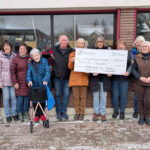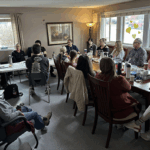Home »

Survey poster wins award; breaks new ground
An award-winning East Kootenay survey and analysis is providing extensive new information into why some youth turn to alcohol and drugs.
A poster produced out of information compiled by Dean Nicholson (pictured above with poster) with the East Kootenay Addiction Services Society (EKAS) and Dr. Elizabeth Saewyc of the U.B.C. School of Nursing was recently honoured as for top ‘Research Poster’ by the Canadian Centre for Substance Abuse during its biennial national conference.
The poster came from new information contained in the ‘Childhood Sexual Abuse, Substance Use and Substance Use-Related Sexual Behaviour in a Rural School Population’ survey and information compiled by the Invermere-born and Cranbrook-based Nicholson and Saewyc. The award-winning poster was produced by Kootenay Kwik Print’s Colleen Nelson.
The purpose of the survey was “to explore the links between sexual abuse, timing of abuse, substance use and sexual harms as a consequence of substance abuse, among adolescent students in rural Western Canada,” notes a breakdown of the survey provided to e-KNOW by Nicholson, who credits the region’s two school districts (No. 5 and 6) for showing courage and leadership in allowing the survey to be completed in the first place.
“We’ve had great support from the school boards,” he said, pointing out that the information compiled in the survey “is hard to find world-wide.”
The work was part of a regular survey conducted every two years by Nicholson and EKAS, with regional students in Grades 7 to 12 taking part in it.
“Every couple of years I introduce a couple of new questions,” Nicholson said, admitting it is extremely difficult to get permission from school boards to include sexual behaviour questions.
A total of 3,781 youth, representing 73.8% of the region’s student population, completed surveys used in the analysis and the results “not surprisingly, show a really strong correlation” between substance abuse and sexual abuse.
“Clinicians have known that anecdotally” but there has been precious little actual research done on the subject, Nicholson said.
Students were asked if they had ever been sexually abused and nine per cent replied in the affirmative, with 77.5% of them being female. They were asked how old they were when first sexually abused, with 56% admitting they were “post-pubertal” or older than 11.
Digging deeper, the survey asked if alcohol or drug use had ever caused the students to engage in unplanned sexual activity, with 24% responding ‘yes.’ Furthermore, 10.6% of those surveyed said they had engaged in unwanted sexual activity because of alcohol or drugs.
Additionally, 3.2% of students admitted they had exchanged sexual activity to pay for alcohol or drugs, a finding that is somewhat shocking considering the mostly rural location of this study, Nicholson said.
“A lot of kids eventually use alcohol or marijuana,” he said, “But there may be something to turning to substance abuse as a coping mechanism.”
A finding from the survey shows that sexually abused boys tend to exchange sex for drugs more than girls, especially if they were younger than 11 when first abused.
“These are all kids in (our) schools,” Nicholson stated, adding they are not homeless kids as one might spot wandering along East Hastings in Vancouver. “It isn’t an inner city area. Yet there is this behaviour happening. It is a concern that hasn’t been on peoples’ radar. These are kids in school, living in two parent homes – they’re normal kids.”
“Who are they exchanging with and why?” Nicholson asked, suggesting the results of this survey could potentially influence policy-making with child protection agencies.
“It’s a feather in the cap,” to this region, he said, noting that there were 50 posters being judged at the conference in Seattle, Wash., with some produced by university researchers.
On the bright side, Nicholson said this is the fifth survey he has conducted with regional school students about drug and alcohol abuse and he’s noted “a fairly significant decrease” in use of all substances among kids, except ecstasy.
Nicholson said he intends to share his findings with regional schools and via peer journal articles, and on the web.
“It’s a heads up. It’s one more thing to be aware of,” he said.
“Childhood sexual abuse has been recognized as a risk factor for problems later in life. This research demonstrates that childhood sexual abuse is strongly correlated with substance use and substance use-related sexual behaviours in adolescents. Further, the difference in odds rations for various behaviours depending on gender and age of abuse, suggests that the timing of the sexual abuse has implications with respect to psycho-social development, coping and exposure to increased risk,” Nicholson outlined in his survey conclusions.
“Sexual abuse prevention programs, or early intervention when sexual abuse is reported, may have additional benefits by contributing to delayed and/or reduced substance use, as well as reducing unwanted or risky sexual behaviours due to substance use,” he said.
Nicholson’s survey was funded in part by Interior Health and from a Canadian Institute of Health Research grant.
Ian Cobb/e-KNOW







